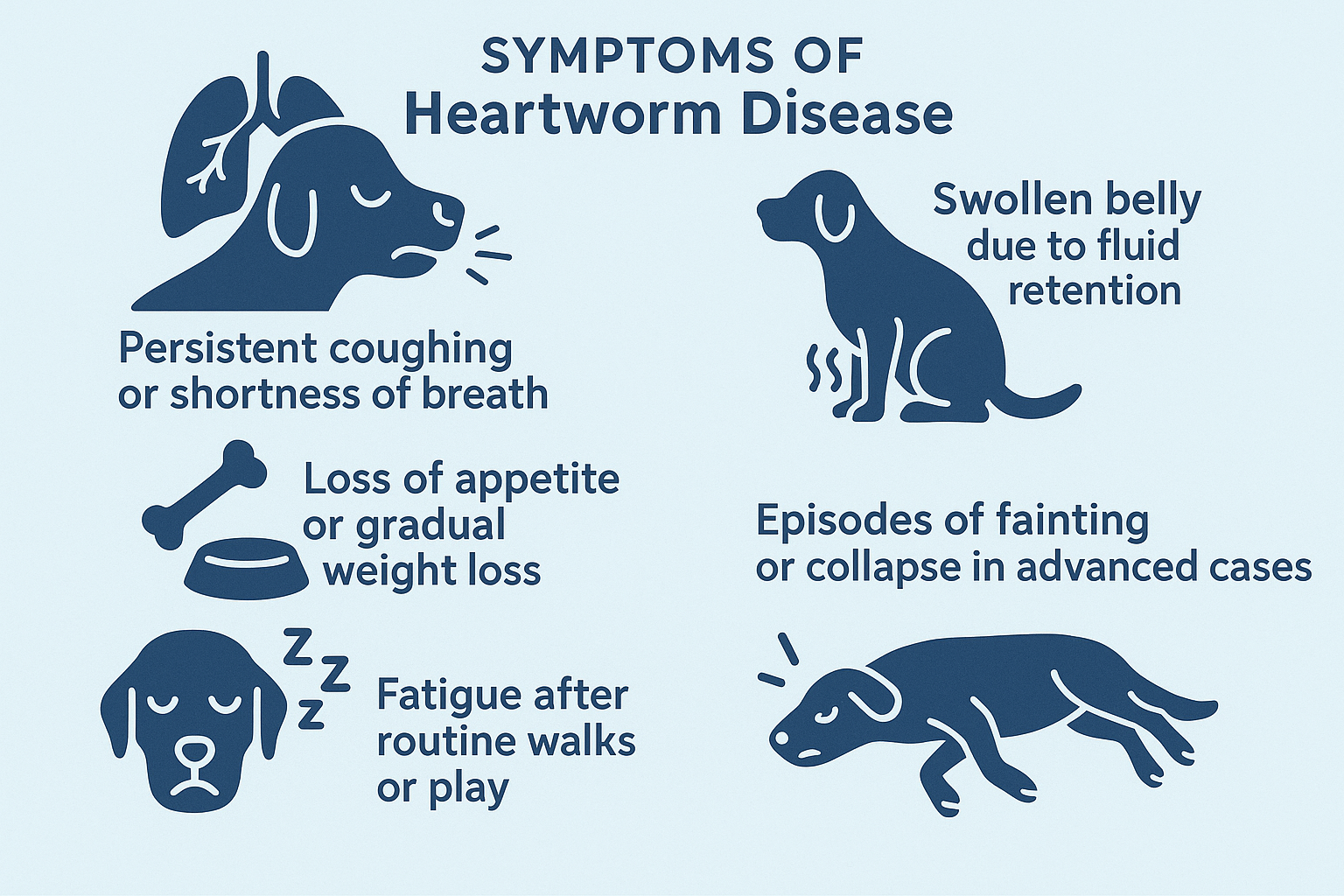Heartworm is not a new threat, but many dog owners still underestimate how severe it can become. Transmitted through a single mosquito bite, heartworm disease progresses quietly at first, giving little warning until the damage is already underway. Once mature worms take hold in a dog’s heart and lungs, they can cause respiratory failure, circulatory strain, and in severe cases, death.
Because of its slow progression and vague early symptoms, heartworm is often referred to as a silent killer. By the time clear signs emerge, a dog’s health may already be compromised. That’s why prevention remains the most critical step any owner can take.
How heartworm infection works
Heartworm disease is caused by Dirofilaria immitis, a parasitic worm that completes its lifecycle inside a dog’s cardiovascular system. It begins with a mosquito bite. Larvae enter the bloodstream and, over six months, mature into long worms that settle in the heart, lungs, and major arteries. There, they reproduce and release microfilariae, which mosquitoes can pick up and transmit to other animals.
This process can continue silently for months. Once symptoms appear, they often reflect significant organ stress, especially in the heart and lungs.
Recognizing early and advanced symptoms
Initial signs of heartworm disease may be so mild that they go unnoticed, especially in young or active dogs. However, even subtle changes can be meaningful if they persist. Common signs include:
- Persistent coughing or shortness of breath
- Fatigue after routine walks or play
- Loss of appetite or gradual weight loss
- Swollen belly due to fluid retention
- Episodes of fainting or collapse in advanced cases

Prevention: your strongest defense
The best approach to heartworm is to avoid it altogether. Preventive care is affordable and widely accessible. Monthly oral medications, spot-on treatments, or long-acting injections are designed to kill heartworm larvae before they reach maturity.
Preventive strategies include:
- Administering preventives on a consistent monthly schedule
- Avoiding exposure to mosquitoes, especially during peak hours
- Having your dog tested for heartworm at least once a year
Preventives do not treat existing infections, so even a single missed dose can leave a dog vulnerable. Consistency is not just about routine, it’s about reducing the risk of irreversible damage.
When a dog tests positive
If your dog tests positive for heartworm, the next steps depend on how advanced the disease is. Treatment is possible, but it must be handled carefully to avoid complications from dying worms blocking blood vessels.
Treatment may include:
- Strict exercise restriction to avoid increasing the strain on the heart
- Antibiotics and anti-inflammatories to reduce complications
- An adulticide injection that targets and kills mature worms
- Regular monitoring over several months to confirm the disease has been cleared
Even after successful treatment, dogs may require long-term monitoring for secondary effects. The process is expensive, slow, and not without risk. That said, many dogs go on to live full lives with proper care and rest.
When the disease is too far along
In advanced cases of heartworm, particularly in older dogs or those with pre-existing conditions, treatment may not be an option. The worms may already be causing organ failure, and attempting to remove them could cause more harm than good.
In these heartbreaking moments, owners often face end-of-life decisions. It is here that grief takes on a new dimension, not just the sadness of impending loss, but the weight of choosing how and when to say goodbye. This experience is deeply personal, and no two paths are the same.
Cryopreservation: a path for both humans and pets
Cryopreservation is not just for humans. It is also available for pets, offering a scientifically grounded option for those who wish to preserve the body of a beloved animal after legal death. The goal is to maintain biological structure at ultra-low temperatures, allowing for the possibility that future advancements may one day enable revival and treatment.
At Tomorrow.bio, we provide cryopreservation for individuals who face the limits of current science and want to extend the potential for life. It is not a guarantee, and it is not a substitute for today’s care. But for some, it represents a meaningful decision when all other paths have come to an end, a decision grounded in both science and hope.
About Tomorrow.bio
At Tomorrow.bio we are dedicated to advancing the science of cryopreservation with the goal of giving people a second chance at life As Europe’s leading human cryopreservation provider we focus on rapid high-quality standby, stabilization and storage of terminal patients preserving them until future technologies may allow revival and treatment.
Our mission is to make human cryopreservation a reliable and accessible option for everyone We believe that no life should end because current capabilities fall short.
Our vision is a future where death is optional where people have the freedom to choose long-term preservation in the face of terminal illness or fatal injury and to awaken when science has caught upInterested in learning more or becoming a member
📧 Contact us at hello@tomorrow.bio
🌐 Visit our website www.tomorrow.bio
🤝 Schedule a call with our team Book a consultation



